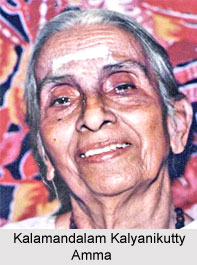 Kalamandalam Kalyanikutty Amma was a legendary Mohiniyattam dancer from Kerala in southern India. A recipient of Sangeetha Nataka Academy Award, she is regarded as the "Mother of Mohiniyattam". She had played a pivotal role in resurrecting Mohiniyattam from a near-extinct state into a mainstream Indian classical dance. Her life long efforts revived this art form from the social degradation and gave it a solid foundation and structure.
Kalamandalam Kalyanikutty Amma was a legendary Mohiniyattam dancer from Kerala in southern India. A recipient of Sangeetha Nataka Academy Award, she is regarded as the "Mother of Mohiniyattam". She had played a pivotal role in resurrecting Mohiniyattam from a near-extinct state into a mainstream Indian classical dance. Her life long efforts revived this art form from the social degradation and gave it a solid foundation and structure.
Early Life of Kalamandalam Kalyanikutty Amma
She was born in the year 1915. She was a native of Thirunavaya in Malappuram district of the state.
Career of Kalamandalam Kalyanikutty Amma
Kalayanikutty Amma developed an interest in Mohiniyattam in her early twenties. She joined Kerala Kalamandalam to learn this dance form. She was one of the early-batch students of Kerala Kalamandalam. However, she had to face lots of difficulties as during those days dancing was not considered appropriate for aristocratic families. She was turned out of her home and was denied everything she was entitled to.
Later when she completed her studies, she was asked by Poet Vallathol to spread awareness about Mohiniyattam. He handed her the responsibility of elevating Mohiniyattam to a better status in society. To accomplish this mission, she traveled all over Kerala and visited numerous temples. She also developed many basic steps and a repertoire format for this classical dance form. Her life long commitment was able to revive Mohiniyattam and give it a position among other classical dance forms of India. Her notable disciples are her daughters Sreedevi Rajan and Kala Vijayan and Mrinalini Sarabhai and Deepti Omchery Bhalla.
Personal Life of Kalamandalam Kalyanikutty Amma
Kalyanikutty Amma had tied the knot with late Kathakali maestro Padma Shri Kalamandalam Krishnan Nair. Her son Kalasala Babu is a cinema and television actor, while her granddaughter Smitha Rajan is a well-known Mohiniyattam artiste. Kalyanikutty Amma breathed her last on May 12, 1999 in Tripunithura at the age of 84.
Achievements of Kalamandalam Kalyanikutty Amma
Her noteworthy contribution in the field of this classical dance form made her win several awards which are as follows-
•She was awarded Natya Praveene by Kerala Fine Arts Society in 1982.
•She received Keerthi Shanghu from Kerala Kalamandalam in 1980.
•She was honoured with the coveted Kalidasa Puraskar by Madhya Pradesh government for her work in Indian Classical dance in 1997.
•She was honoured by both Kerala Sangeetha Nataka Academy and Kendra
•Sangeetha Nataka Academy in 1974 for her immense contributions to Mohiniyattam. In the same year, Kendra Sangeetha Nataka Akademy conferred on her the title Guru.
•She received a Fellowship from Kendra Sangeetha Nataka Academy in 1972.



















